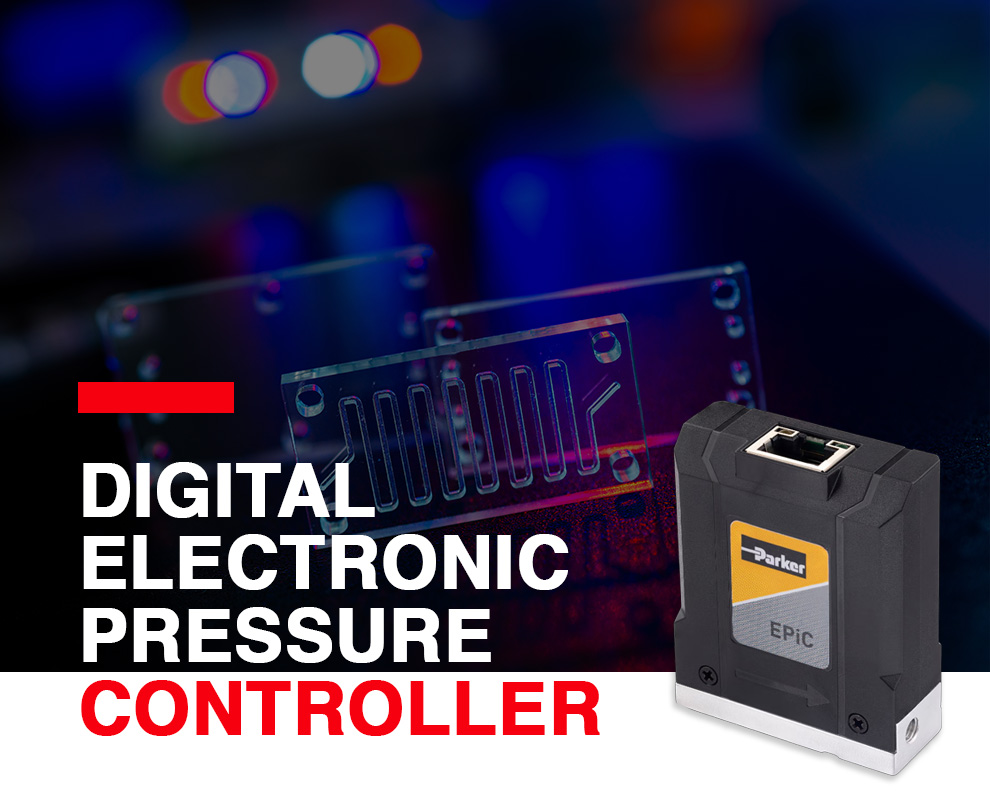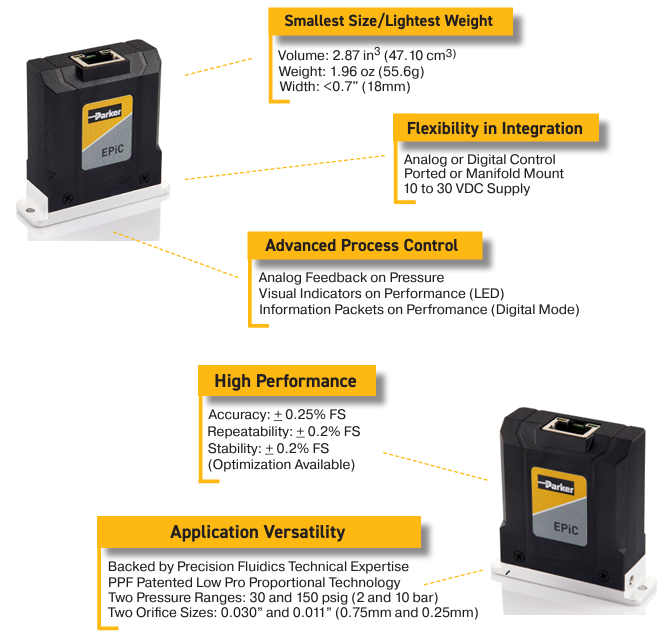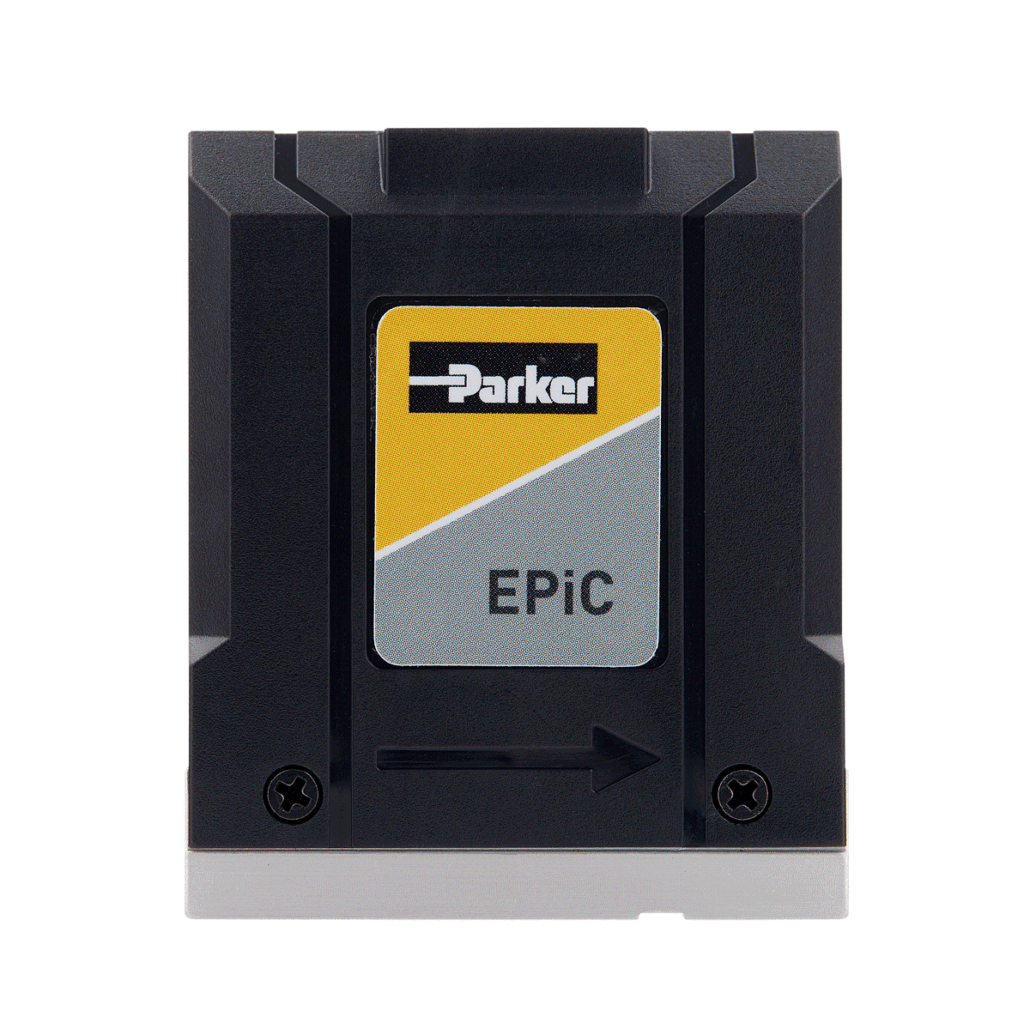Parker EPiC Digital Pressure Controller: precision in microfluidics

Introduction
The Parker EPiC Digital Pressure Controller sets a new standard for high precision pressure control in microfluidic systems, analytical instruments, and next generation diagnostic equipment. This blog provides a complete overview of what the EPiC is, how it works, why it outperforms traditional technologies, and in which applications it creates direct value.
What the EPiC Digital Pressure Controller Delivers
The EPiC Digital Pressure Controller provides accurate and stable pneumatic output up to 150 PSI. It replaces manual regulators and variable valves with a controlled digital system. The controller combines an internal pressure sensor with LowPro proportional valve technology. This combination produces controlled, repeatable and stable output pressure with an accuracy rating of plus 0.25 percent of full scale and a resolution of 0.02 percent in digital mode.
Why Pressure Control Matters in Microfluidics
Microfluidic systems handle small fluid volumes. These volumes require stable flow without pulsation. Many next generation applications include DNA sequencing, liquid biopsy, blood gas analysis or rapid diagnostic tests. These processes need accurate sample movement to maintain data quality. The EPiC supports these needs by maintaining stable pressure with a stability rating of plus 0.2 percent of full scale. This stability reduces unwanted fluctuations.
Limitations of Traditional Pump Technologies
Peristaltic pumps press tubing to move fluid. This creates pulsation and limits flow accuracy. Tube material changes over time and causes variation in performance. Syringe pumps deliver a more stable flow but have slow response time and limited volume. Both technologies introduce error sources that affect measurements. Pressure driven flow control offers a stronger approach because it applies controlled gas pressure over the liquid reservoir. This avoids direct contact between fluid and pump components which reduces contamination risk.
|
Feature |
Peristaltic Pump |
Syringe Pump |
Pressure Controller (EPiC) |
|
Flow Stability |
Low |
Medium |
High |
|
Response Time |
High |
Low |
High |
|
Precision |
Low |
Medium |
High |
|
Volume Limitation |
No |
Yes |
No |
|
Pressure Control |
No |
No |
Yes |
|
Noise |
High |
Low |
Low |
|
Pulsation |
Present |
Minimal |
None |
How the EPiC Maintains Control
The EPiC uses a closed loop control system. A microprocessor compares the setpoint with the measured pressure value. It then adjusts the valve position until the pressure matches the desired value. This active control produces consistent flow and fast reactions to changing conditions. The device responds within 100 milliseconds which suits real time protocols.
Benefits of Digital Process Integration
Digital communication is available through RS485. Analog control is available with 0 to 5 volt and 0 to 10 volt inputs. Pressure feedback information helps monitor system behavior. Status indicators and LED lights show operational conditions. The device draws only 1 watt nominal power which suits energy conscious systems. Operating temperature goes from 0-60 degrees Celsius with relative humidity up to 95% non-condensing.
Compact Design for Easy Integration
The EPiC has one of the smallest footprints in its class. It weighs 55.6 gram and the volume is under 48 cubic centimeter. Width is below 18 millimeter. This compact size allows integration in handheld instruments and space restricted life science equipment. Engineers can choose either M5 threaded ports or a face seal manifold mount.
Material Compatibility
Internal wetted materials include stainless steel, aluminum, nickel, brass, silicone adhesive, FKM, PPS polymer and epoxy. These materials support non corrosive gases and deliver reliable performance in clinical and analytical environments.
Pressure Range and Orifice Selection
The EPiC comes in two pressure ranges. One range covers zero to 30 PSI for low pressure systems. The other covers zero to 150 PSI for higher demands. Two orifice sizes determine flow capability. A 0.011 inch orifice supports low flow applications that require tight stability. A 0.030 inch orifice supports higher flow systems.
Vented and Non-vented Configurations
Applications that do not consume gas require a venting controller. The vented version includes an internal vent orifice sized at about 40% of the main orifice. Applications that consume gas or use limited gas sources can use a non-vented version. This version requires downstream restriction between 20% and 60% of the orifice size. This ensures stable pressure buildup.
Performance Improvement Compared to Mechanical Regulators
Manual regulators are sensitive to supply changes, temperature drift and mechanical wear. The EPiC digital control eliminates these variations. It maintains consistency over long periods without user interaction. This stability improves uptime and reduces maintenance time.
Conclusion
The EPiC Digital Pressure Controller delivers stable, accurate and repeatable pressure control in compact form. It supports microfluidic systems, diagnostic equipment and analytical instruments. With digital integration, high performance valve technology and strong stability, it becomes a reliable choice for modern life science and high technology applications.
The Parker EPiC Digital Pressure Controller is available at A&C Engineering. Feel free to contact us for product information, inquiries, integration support or technical questions.





